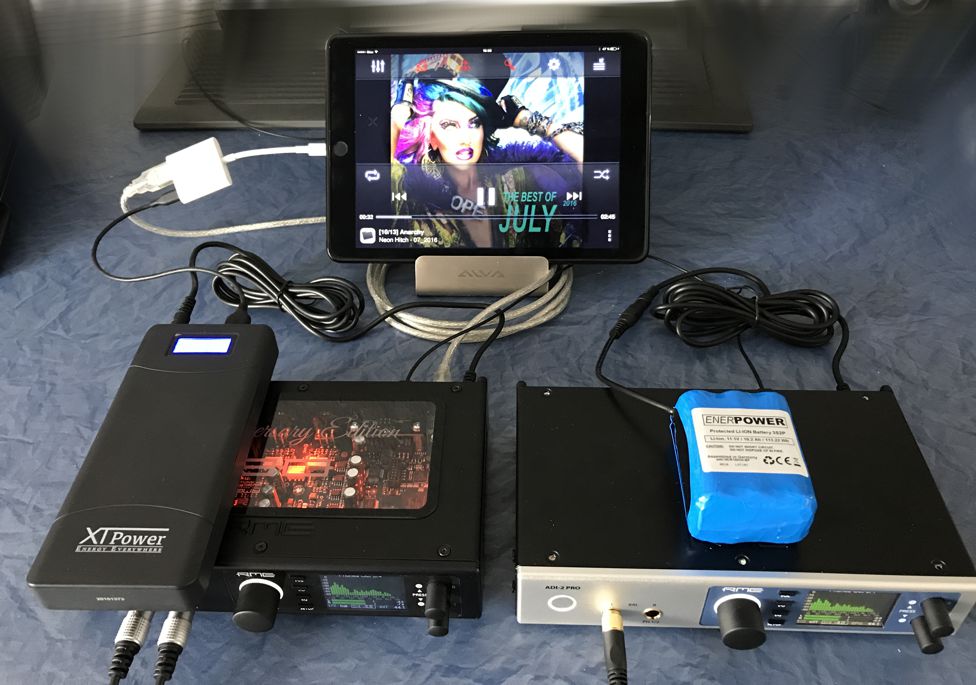Topic: 12 V Battery Power Solutions
No matter if for mobile usage, measurement applications or High-End listening experience, there is demand for battery operation of Fireface UC, Babyface Pro, ADI-2 Pro and other RME units that are or can be powered by an external 12 V power supply. Let me give two tips on how to achieve this with the biggest ease, comfort and best real-world results.
It seems not well known that the popular (and cheap) powerbanks, rechargable 5V batteries with USB port(s), are also available in versions having a 12V output. Based on 3.7V Li-Ion or LiPo batteries, which do not suffer from memory effects and deliver a lot of power at lowest space and weight, an internal switching power supply circuit not only ups the voltage to 5 Volts, but also to 12 Volts. A recommendation based on personal experience is the XTPower XT-20000QC2:
https://www.amazon.de/XTPower%C2%AE-XT- … B07PY8516W
(Note: Link now points to the newer QC3 version)
This powerbank is quite amazing, and works flawlessly with the ADI-2 Pro or any other 12V operated RME interface. I'm sure the smaller version available (15,600 mAh) does as well.
This powerbank is compact and not too heavy. It has some really nice features: two USB ports which are fully compatible to Apple (both charged my iPad with 2.1 A), one of both also supports Quick Charge 2 (Android). One standard DC output for 12 up to 24 V, adjustable. It can provide a lot of power (65 W). The ADI-2 Pro, playing music to a headphone, played exactly 5 hours. The LCD tells you how much Watts are currently drawn (between 12.5 and 14 with the ADI-2 Pro), what output voltage is selected (I chose 12V), and how much juice is left (switched itself off shortly after 0% was shown). The display is more accurate than I expected, for both state and power measurement.
I also measured the quality of the 12V output. The lower voltage of the internal LiPos is processed by some step-up regulator to 12, 16.5, 19, 20, or 24 V. On my older 10,000 mAh powerbank I can clearly see the switching frequency as needle within a spectrum measurement. This newer 20,000 mAh version either has a better stepup regulator or better filtering - there is no switching needle visible at all.
Finally this powerbank can not only be charged via 5V mini USB (which takes some time), but also backwards via the DC output. The optional power supply charges it with up to 30 W (also displayed on the LCD) via 20V and 2A, so charging takes about 2.5 hours only.
Yes, latest technology can be quite amazing, and this powerbank also is extremely flexible in overall usage, clearly worth the money asked.
Let's put away all the nice flexibility and additional features in my second recommendation, concentrating on the pure battery functionality. The powerbank uses an internal step-up switching regulator to turn 3.7V into 12V. There are two (minor) drawbacks: the regulator needs some energy on its own, and the DC output is not 100% clean, as you would expect it from a real battery. The solution here is to use the same technology as in the powerbank, modern Li-Ion cells, but connected in series to raise the voltage. In a so called 3S2P configuration the popular 18650 cells will deliver between 12.6 Volts (fully charged) and 9 Volt (discharged). Typical voltage provided is 11.1 Volt.
In the 3S2P configuration 3 cells are connected in series for higher voltage, and another 3 in parallel to double the available power. The total power of such a small block of cells is astonishing. Don't get fooled by comparing the powerbank's 20,000 mAh with their 6,900 mAh - one refers to 3.7V, the other one to 11.1V. For a valid comparison use the Watts per hour value, where both provide nearly the same - around 70 Wh.
I got my 3S2P block from here:
https://enerprof.de/akkus/li-ion-akkus- … -3x2?c=22/
As you can read here the block already comes with overvoltage, undervoltage and short-circuit protection. To connect it to an RME unit one can buy a pre-made cable like this one
https://www.amazon.de/Anschluss-Anschlu … B079J95WND
or make one yourself with the lockable connector on one end. This battery gives the purest, clean power possible, cost less than half of the above powerbank, is even more small and light weight, and amazingly powerful. The same headphone test with ADI-2 Pro described above caused the battery to reach 10.0V after 4 hours and 15 minutes of operation. After 5 hours and 17 minutes the battery was down to 9.3V and the ADI-2 Pro switched off audio. Until then the ADI-2 Pro, consuming about 12 Watts, had worked perfectly. A Babyface Pro would run more than double that time!
A quick (and cheap) charger for the 3S2P is also available:
https://enerprof.de/ladegeraete/ladeger … -8v-11-1v/
Matthias Carstens
RME
